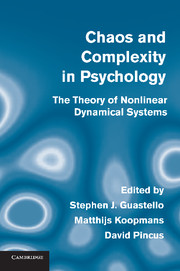Book contents
- Frontmatter
- Contents
- Contributors
- Preface
- 1 Introduction to Nonlinear Dynamics and Complexity
- 2 Collective Intelligence: Observations and Models
- 3 Neurodynamics and Electrocortical Activity
- 4 Psychophysics
- 5 Temporal and Spatial Patterns in Perceptual Behavior: Implications for Dynamical Structure
- 6 Embodied and Embedded: The Dynamics of Extracting Perceptual Visual Invariants
- 7 Origins of Order in Cognitive Activity
- 8 Nonlinear Complex Dynamical Systems in Developmental Psychology
- 9 Developmental Psychopathology: Maladaptive and Adaptive Attractors in Children's Close Relationships
- 10 Psychopathology
- 11 Coherence, Complexity, and Information Flow: Self-Organizing Processes in Psychotherapy
- 12 The Dynamics of Human Experience: Fundamentals of Dynamical Social Psychology
- 13 Group Dynamics: Adaptation, Coordination, and the Emergence of Leaders
- 14 Organizational Psychology
- 15 Complexity, Evolution, and Organizational Behavior
- 16 Agent-Based Modeling Within a Dynamic Network
- 17 Epilogue: Psychology at the Edge of Chaos
- Index
8 - Nonlinear Complex Dynamical Systems in Developmental Psychology
Published online by Cambridge University Press: 18 December 2013
- Frontmatter
- Contents
- Contributors
- Preface
- 1 Introduction to Nonlinear Dynamics and Complexity
- 2 Collective Intelligence: Observations and Models
- 3 Neurodynamics and Electrocortical Activity
- 4 Psychophysics
- 5 Temporal and Spatial Patterns in Perceptual Behavior: Implications for Dynamical Structure
- 6 Embodied and Embedded: The Dynamics of Extracting Perceptual Visual Invariants
- 7 Origins of Order in Cognitive Activity
- 8 Nonlinear Complex Dynamical Systems in Developmental Psychology
- 9 Developmental Psychopathology: Maladaptive and Adaptive Attractors in Children's Close Relationships
- 10 Psychopathology
- 11 Coherence, Complexity, and Information Flow: Self-Organizing Processes in Psychotherapy
- 12 The Dynamics of Human Experience: Fundamentals of Dynamical Social Psychology
- 13 Group Dynamics: Adaptation, Coordination, and the Emergence of Leaders
- 14 Organizational Psychology
- 15 Complexity, Evolution, and Organizational Behavior
- 16 Agent-Based Modeling Within a Dynamic Network
- 17 Epilogue: Psychology at the Edge of Chaos
- Index
Summary
Introduction
A good method for obtaining an idea of what a scientific discipline – developmental psychology in this particular case – entails is to browse through introductory student handbooks (Berger, 2003; Bukatko & Daehler, 2001; Cole & Cole, 1993; Kail, 2001; Newman & Newman, 2006; Sigelman & Rider, 2006; Seifert & Hoffnung, 1991; Vasta, Haith, & Miller, 1995). The consulted handbooks either focus on childhood to adolescence or on the human life span. The first chapters typically provide an overview of the “perspectives” on development and comprise a selection of theories ranging from psychodynamically (Freudean) inspired via learning theory to theories of Piaget and Vygotsky. Most handbooks address the nature–nurture problem, discussing the effect of genes and environment on development and present some sort of interactionist or trans-actionist approach. The main chapters are divided according to two dimensions. One is a content or domain dimension and comprises physical, cognitive, and social aspects of development. The other dimension refers to age and amounts to a distinction in phases or “ages.” The standard children-and-youth division encompasses prenatal development and birth; infancy (0–2 years); preschool years (2–6), childhood (6–12), and adolescence (12–21). For each phase or stage, typical developments are described, such as the development of attachment in the first year of life, the development of theory of mind at around 3 years, the emergence of logical thinking (including conservation and other Piagetian themes) around age 5, and so forth.
- Type
- Chapter
- Information
- Chaos and Complexity in PsychologyThe Theory of Nonlinear Dynamical Systems, pp. 242 - 281Publisher: Cambridge University PressPrint publication year: 2008
- 17
- Cited by



